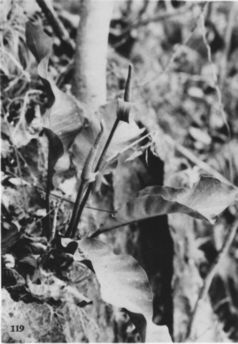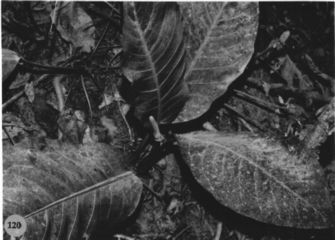





Bol. Soc. Bot. Mexico 24: 35, Fig. 1. 1959. TYPE: Mexico. Oaxaca: Nizanda near the Isthmus of Tehuantepec (16°40'N, 95°2'W) dry, rocky hill, MacDougall s.n. (January 6, 1959) (MEXU, holotype).
Anthurium kruseanum Matuda, Anales Inst. Biol. Univ. Nac. Mexico 36: 107, Fig. 1. 1966. typh: Mexico. Guerrero: La Junta (at junction of Río Omitlan and Río Papagayo) south of Tierra Colorada, on rocks in shade, Hubert Kruse 881 (MEXU, holotype).
LEAVES erect-spreading; petioles 6-15 cm long, 5-6 mm diam., subquadrangular to subterete, broadly and sharply sulcate, sometimes tinged with red-violet; geniculum 1-1.5 cm long; blades narrowly obovate to obovate-elliptic, subcoriaceous, 25-36.5 cm long, 10.7-18 cm wide, broadest just above middle, acute at apex and base (the tip glandular); the upper surface matte to semiglos-sy, the lower surface matte, both surfaces having short, linear raphide cells, the epidermal cells mounded (i.e., raised and convex); the midrib acutely raised above, convexly raised below; primary lateral veins 6-8 per side, departing midrib at 50°-60° angle, prominent above and below; straight to weakly arcuate-ascending to collective vein; lesser veins scarcely visible and flat on both surfaces; collective vein arising from one of the primary lateral veins near middle of blade, 3-9 mm from margin, loop-connected with the remaining primary lateral veins.
INFLORESCENCE erect, equalling or longer than leaves; peduncle 31-55 cm long, 5-8 mm diam., terete; spathe subcoriaceous, green, ovate-lanceolate, ca. 8 cm long, 2.5 cm wide, broadest near the base, inserted at 45° angle on peduncle; spadix pale green becoming reddish-brown, 12-14 cm long, 9-11 mm diam. at base, 4 mm diam. at apex; the flowers rhombic, 1.8-2.5 mm long, 2.8-3 mm wide, the sides sigmoid; 7-9 flowers visible in the principal spiral, 5-6 flowers visible in the alternate spiral; lateral tepals 1.5 mm wide, broadly rounded to weakly concave; the pistils not emergent; stigmas broadly ellipsoid; stamens emerging in a prompt, complete sequence, held just above tepals in a contiguous circle around stigma; anthers ca. 0.4 mm long, 0.6 mm wide; thecae ellipsoid, weakly divaricate.
INFRUCTESCENCE pendent: the spathe withered; spadix 6.5 cm long, 1.5 mm wide; berries round, greenish-while, 8 mm long; mesocarp transparent, juicy, pulpy; seeds 1 (2?) per berry, broadly obovoid, pale yellow (B & K. Yellow 9/2.5), tinged with brown at base and on one side, 5.2-5.4 mm long, 4.5-4.7 mm wide, 3.4-4 mm thick, enveloped by a gelatinous sack; appendage minute, translucent, ± gnarled at apex on side, tinged with brown. Figs. 119 and 120.
Anthurium nizandense is endemic to Mexico in southern Guerrero and southern Oaxaca, where it occurs at less than 850 m in seasonally very dry habitats on steep, rocky dins. It is known only from the vicinity of Tierra Colorada in Guerrero and at Nizanda in Oaxaca. The species is a member of section Pachyneurium and is recognized by its greenish-white berries and by its thick, narrowly to broadly elliptic or oblanceolate-elliptic, relatively long-peliolate leaves that arc matte on the lower surface and sometimes exhibit a dense array of minute, linear raphide cells on drying. It has at least the lower primary lateral veins extending to the margin. Matuda reported the petiole to be subquadrangular, but this was possibly due to a misinterpretation of the dried specimen since this character is not apparent on the live material. The epidermal cells on both surfaces of the blade are convexly raised. In the area of Mexico where it occurs, A. nizandense could be confused only with A. schlechtendalii ssp. jimenezii, which is more generally abundant and occurs in similar habitats. Anthurium nizandense is distinguished by its proportionately longer petioles and its more typically elliptic blade, which is distinctly matte on the lower surface. In A. nizandense the blades are 1.3-2.5 times longer than the petioles. In A. schlechtendalii ssp. jimenezii, the leaf blades are usually semiglossy beneath and usually 6-10 times longer (rarely as little as 3 times longer) than the petiole.
 |
 |
Mexico Guerrero: Río Omitlan, 850 m,, 15 Jan. 1979, Thomas B.
Croat 45756 (B, CM, K, M, MBM, MO, P, TEX).
Mexico Guerrero:, , Kruse 881 (MEXU).
Mexico Guerrero:, , Kruse 1595 (MEXU).
Mexico Oaxaca:, , McDougall S.N. (MEXU).